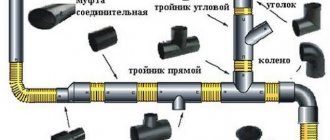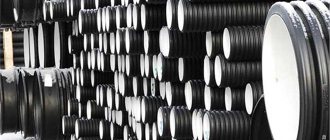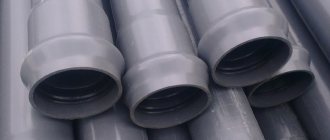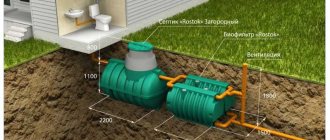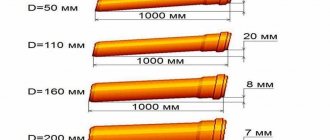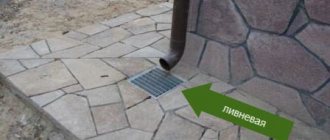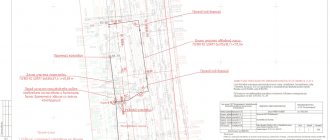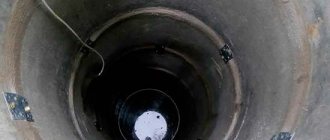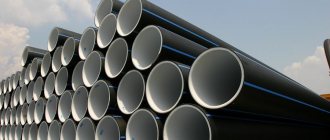Sewer plastic pipes diameters, prices
Every owner wants everything in his household to work, nothing to break, and to be easy to maintain and install. And sewerage is no exception. It needs to require as little attention as possible - it’s very inconvenient if it gets clogged, but it’s no less unpleasant to clean it
If you want to have a trouble-free drainage system, pay attention to plastic sewer pipes. They are gradually replacing cast iron ones, and all because they cost less, are easier to install, have a wide range - different diameters and lengths, almost no deposits form on their smooth walls, and even have a service life of about 50 years
This whole bouquet of properties determines their popularity.
Plastic sewer pipes are made from various polymers and their compositions
Types of plastic sewer pipes
Products made from different types of polymers are sold under the general name “plastic”:
- polyethylene (PE): high pressure (HDPE) - for internal sewerage distribution,
- low pressure (LHP) - can be laid outside, in trenches (have greater strength),
And a number of other thermoplastics and their combinations, but they are rare - people prefer to use already known materials.
The material of plastic sewer pipes is selected depending on the application. For example, polypropylene is more suitable for installing sewerage inside a house or apartment. It has a higher operating temperature range - it normally tolerates environments up to 70°C, and for a short time - up to 95°C. If you have various household appliances that discharge waste hot water into the sewer, this will not be superfluous. PVC pipes, which have lower prices, are more appropriate when laying external sewers - here the drains are usually already mixed, so the temperatures are lower and PVC can withstand them without harm (working up to +40°C, short-term increase to 60°C).
An example of an in-house sewerage system made from plastic pipes
Sewer pipes can also be smooth or corrugated. Moreover, not only siphon bends can be corrugated. There are profiled pipes for sewerage with an internal smooth wall and an external ribbed one. They have greater strength - they can better withstand compressive loads (they have increased ring rigidity) and can be buried to great depths. Available in diameters from 110 mm to 1200 mm.
Dimensions and diameters
Sewage plastic pipes, unlike water and gas pipes, are produced in the form of lengths of 50 cm, 100 cm, 200 cm, etc. - up to 600 cm. The maximum length is 12 meters, but some manufacturers can make longer sections upon request. When laying long routes, this is convenient - there are fewer connections, fewer possible places for problems to arise (leaks or blockages).
Another important characteristics of plastic pipes are diameter and wall thickness. In the markings they usually go side by side: the numbers are 160 * 4.2. What it means: the outer diameter of the pipe is 160 mm, the wall thickness is 4.2 mm. It’s worth remembering here that manufacturers indicate the outer diameter of plastic pipes, and many calculations and planning require knowing the inner one. It is easy to calculate: subtract twice the wall thickness from the outer wall: 160 mm - 4.2 mm * 2 = 151.6 mm. Calculations and tables usually show a rounded result—in this case, 150 mm.
Parameters of sewer plastic pipes
In general, the industry produces plastic pipes for sewerage with a diameter of 25 mm. The maximum cross-section depends on the type of pipe (smooth or corrugated) and the material from which it is made. For example, smooth PVC sewer pipes can have a diameter of up to 630 mm, and profiled two-layer pipes can have a diameter of up to 1200 mm. But these dimensions are of no use to homeowners or apartment dwellers. In private housing construction, diameters up to 100-110 mm are mainly used, rarely up to 160 mm. Sometimes, for a large cottage with a large number of plumbing fixtures, a pipe of 200-250 mm in diameter may be needed.
The organization of sewerage at the dacha is described here.
How to choose a diameter for connecting plumbing fixtures
According to the rules, a calculation must be made; it is fully spelled out in SNiP 2.04.01085. This is a complex matter, a lot of data is required, so few people really think as it should. Over the years, accumulated practice has made it possible to derive the average diameters of polyethylene sewer pipes for each of the plumbing fixtures. You can safely use these developments - all calculations usually come down to these dimensions.
Classification
Technical characteristics of PVC pipes.
Communications made of polyvinyl chloride are classified according to the degree of rigidity. The following types of pipes are distinguished:
- Class L (2 kN/sq. m).
- Class N (4 kN/sq. m).
- The thickest-walled products belong to class S (8 kN/sq. m).
The second group of materials can be used for installation of sewerage systems at a depth of 0.8 to 6 m, and pipes representing the third class are intended for installation deeper than a level of 6 m. According to their intended purpose, the following types of products are distinguished:
- light type, communications are used during the construction of sewer systems in areas with low load (green areas, sidewalks);
- medium type, pipes of this group are used when laying systems passing under roads with low-intensity traffic;
- heavy type, communications of this design are used in areas characterized by heavy traffic loads.
The service life of the entire sewage system will depend on how correctly the products are selected. Therefore, when choosing, you should pay attention to the features and parameters of the pipes. The range of standard sizes of PVC communications is very wide. Thus, the outer diameter of the products varies from 11 to 63 cm, and the wall thickness can correspond to any value from the range from 3.2 to 15 mm.
The shade makes it easy to navigate when choosing communications for laying external sewerage systems. The main colors of this type of product are: brick, gray, red.
Types of plastic sewer pipes and their sizes
Plastic sewer pipes are made from the following materials:
- high and low pressure polyethylene;
- polyvinyl chloride;
- polypropylene.
The material for the drain depends on the area of application.
Polypropylene elements are more suitable for internal networks. They are able to withstand temperatures up to +70°C. In some cases, it can be tolerated for a short time up to +95°C. Pipes made of this material are suitable for systems that receive waste water from various household appliances.
Cheap PVC products are used when installing an external channel in which mixed wastewater moves. Their temperature is lower than in the internal network. Their operating indicator is +40…+60°С. Parts are divided into corrugated and smooth. Corrugated parts are used not only for installing siphons. Pipes with a ribbed outer wall, but a smooth surface inside, are characterized by increased strength.
Types of plastic sewer pipes.
Such parts withstand compression well and are suitable for a system that runs deep underground. The diameter of the products can be 110-1200 mm. The large size is designed for increased loads. These elements are used in the maintenance of apartment buildings, social buildings and cottages.
The 200 mm size is used for installation of sewerage systems in hotels, saunas and hospitals. When the diameter increases to 300 mm, the pipeline is installed for industrial facilities.
For individual construction work, elements with a small circumference are used. If the riser is mounted from 150 mm pipes, then it will no longer be fully functional if there are several bathrooms in the apartment.
Square-shaped products are used to install a network, which is intended for irrigating a personal plot.
To organize drains for individual plumbing equipment, 75 mm pipes are used. To install toilets, you will need a wider pipeline.
Advantages of PVC pipes
Metal-polymer pipes are particularly durable elements. Plastic parts are easy to install and require less time and effort to install. Good throughput allows you to bend the pipeline at different angles. Installation with plastic elements can be done independently.
Their advantages include:
- low thermal conductivity;
- light weight (unlike cast iron construction);
- reliable protection against the spread of bacteria and viruses;
- resistance to corrosion, external factors and chemicals;
- affordable price (unlike products made of cast iron);
- long service life.
When installed correctly, a plastic sewer system can last a long time. In this case, the pipes do not need to be constantly maintained. Increased strength allows the use of parts for mounting a pressure network. The disadvantages of PVC include fragility when the temperature drops below -18°C.
Advantages of a pipeline made of polyvinyl chloride
Among building materials, equipment related to PVC sewer pipes and not exposed to aggressive environments is very popular. The risers have a single-layer or three-layer structure, and their outer and inner shells consist of primary polyvinyl chloride.
Characteristics of PVC sewer pipes.
If you decide to install a sewer system made of PVC materials, then you need to familiarize yourself with the properties of polyvinyl chloride in advance. After all, after a certain period of time, the indicators characterizing the strength of the material change, and the degree of load on the sewer networks increases.
If you are installing external networks, PVC pipe is the best material for the job, because... it is frost-resistant and has high strength indicators. Pipes intended for installation of internal systems provide high-quality work, but have lower parameters. The material used to create the sewage removal system must have high strength and withstand the maximum load on the pipes.
The creation of positive characteristics for PVC pipes is influenced by the toxicological and biological safety of the material.
PVC sewer pipes for external sewerage have quite a lot of advantages that simplify the installation process and make the communication system unaffected by external factors. Main advantages:
Scheme of laying sewer pipes.
- Increased strength: the range of PVC products is presented in several versions, which differ, first of all, in the safety factor, for example, some pipes can withstand loads of up to 10 MPa (the coefficient value is 2.5), other products can be freely operated at a pressure equal to 12.5 MPa (coefficient is 2).
- Light weight, which greatly simplifies the installation process, since there is no need to use special equipment to perform installation work.
- Simplicity of connections of individual sections of the pipeline, which is due to design features: each pipe at one end has an extension (socket), respectively, the two products are very simply connected, since it is enough to insert one pipe into the socket of the other, and the seal is ensured by a rubber O-ring.
- A high degree of resistance when in contact with aggressive substances, and in addition, PVC products are not subject to corrosion and do not deform due to temperature changes.
- The internal surface of the communications is smooth, and this allows wastewater to move through the system unhindered; for the same reason, plaque does not form so intensively on the walls.
- Resistance to damage from the inside, which is especially important if solid fractions of contaminants are present in the wastewater;
- PVC products are not exposed to ultraviolet radiation.
- Long service life, which can be further extended if you do not allow sewer drainage at temperatures above 45 degrees;
- Polyvinyl chloride is a low-flammable material.
PVC communications, through which external sewer networks are installed, do not require the use of special equipment (welding machine); a hacksaw for metal is enough to cut them. To the list of advantages it is necessary to add the affordable cost of materials.
Standard sizes of sewer pipes table, markings, GOST
To install a sewerage system, it is necessary to purchase pipe products and connecting elements of the sizes specified in the project. The trade offers standard sizes of sewer pipes in a fairly wide range, which allows you to create a pipeline of any configuration with any wall thickness.
Main parameters of the pipeline
- outer diameter of the sewer pipe,
- inner diameter,
- conditional diameter (Dу or Ду) - nominal or rounded value of the internal section,
- nominal cross-section (Dn or Дн),
- wall thickness.
The marking of all plastic pipe products indicates the outer cross-section and wall thickness, while for cast iron pipes the nominal bore in millimeters is indicated. Problems may arise when combined fittings (made of metal and plastic), which are marked in millimeters and inches, are used during installation. In such situations, it is necessary to compare elements in different measurement systems.
SNiP 2.04.01-85 determines the calculation of the diameter of the sewer pipe. But for a house or apartment these formulas are too complex. In practice, a different approach is used - in an apartment or standard country house it does not exceed 10 cm.
Based on this:
- for sink, bathtub, washbasin, urinal, bidet - 5-7.5 cm,
- for the toilet - plastic pipes with a diameter of 100 or 110 mm,
- outlets from washing machines and dishwashers - 2.5 or 3.2 cm,
- wiring around the house or apartment - 5 cm,
- riser in a house with no more than five floors - internal Ø 110,
- riser in a house above five floors - Ø160,
- connection of several risers (lounger) in a multi-storey building - 200,
- drain outlet outside - 16 or 20 cm,
- yard system - Ø 300,
- outlet to the well, the area between two wells is 20 cm.
If plastic materials are used to lay the sewer, then instead of 5 cm you can use 4 cm, instead of 10.1 cm - 10 cm, etc. This is due to the smooth inner surface of these products, which during operation is practically not covered with rust or other deposits.
There is such a thing as the smallest permissible standard size, defined by Sanitary Norms and Rules (SNiP):
- for intra-block drainage and street network - 20 cm,
- for intra-block storm drainage network - 20.2 cm,
- for street storm network - Ø 250.
The cross-section and wall thickness are interrelated parameters - the larger the cross-section, the thicker the wall. Weight is also directly proportional to the cross-section. For example, an external cross-section of 16 cm - weight 2 kg, or 10.1 cm - weight just over 1 kg. An important indicator is the length of the segments. The shortest is 1 m, the longest is 6 m.
Plastic pipe products for sewerage
Manufactured from polyvinyl chloride (PVC), polypropylene (PP) and polyethylene (PE). To determine their internal cross-section, you need to subtract the wall thickness multiplied by two from the external cross-section (they are indicated in the marking).
According to GOST R 51613-2000, the diameter of non-pressure PVC sewer pipes can be 5, 7.5, 9, 10, 1.1, 15, 16 cm. To drain wastewater from industrial facilities, products with a cross-section of 25 and 30 cm are used. Their main advantage - they are mounted in the same way as thin ones - in a socket.
The size of polypropylene materials is determined by GOST R 51613-2000 and GOST 22689.2-89 - 5, 10 and 15 cm. But there are large diameters with a wall of 5 mm. These products are used for installation of large main pipelines.
Standard sizes made of polyethylene are regulated by GOST 22689.2-89. The choice of these products is not large - 4.5 cm, 90 and pipe 110 internal diameter. The wall thickness of low-density polyethylene products is 3 - 5 mm. Sold in lengths from 2 to 9 meters.
The diameter of the plastic sewer pipe must be selected based on the availability of connecting elements of appropriate sizes. For example, for material with a cross-section of 7.5 or 9 cm, it may not be possible to find fittings.
To connect a plastic indoor sewer system to a cast iron riser, you can use a combined fitting or a rubber gasket, which is sealed with silicone or linen winding. If there is a large hole in a cast iron riser, you can combine a fitting and silicone or a fitting and a winding.
Requirements for pipes of external sewerage networks
Some time ago, cast iron, ceramic and asbestos-cement products were the only available options when laying sewer lines. But they are characterized by quite a large number of disadvantages, among which are large weight, difficult installation, and the need to use special equipment for lifting and laying such pipes. Thanks to technological progress, polymer products, in particular those made of polyvinyl chloride (PVC), have appeared on the market. And installation is now carried out according to a simplified scheme without the need to make great efforts.
Minimum slope of external sewerage pipes.
The main requirements for the pipes of the external communications network for draining wastewater from the facility have not changed:
- increased degree of strength, since this type of communication will have to withstand loads in difficult areas, for example under highways;
- resistance to aggressive substances;
- wear resistance;
- products should not deform or crack under the influence of constant temperature changes and when used in harsh climatic conditions.
If all the above parameters are characteristic of pipes, then such products can be used without hesitation for the installation of external systems. In addition, the listed requirements determine another important parameter, namely the long service life of communications. After all, if the pipe does not deform under different operating conditions, is strong enough and is wear-resistant, then it will last a long time. And this is an important nuance, given that it is quite difficult to restore the external drainage system.
Preparatory stage for pipe installation
First of all, it is necessary to draw up a diagram of the future communication system, perform calculations of consumables, calculate the number and sizes of fittings and parts necessary for the work. In addition to straight pipes, many more connecting elements are produced for convenient sewer installation. They come in different sizes and designs.
Their main types:
Preparatory stage
- crosses and tees for creating pipe routing;
- couplings and expansion pipes that are needed for repairs;
- reductions for connecting pipes with different diameters;
- rotary bends;
- plastic hatches for inspection and cleaning of blockages.
When drawing up a plan, it is necessary to provide for a smooth transition in those places where turns are necessary - instead of one rectangular connection, install two 45-degree fittings. This will avoid blockages.
When purchasing pipes and additional parts, it is necessary to calculate the consumption of materials with a margin of approximately 15% more, so that later there will be no downtime. With proper preparation, installation work can be completed in a private house in a few days, and in an apartment in a few hours.
Recommended pipe sizes
The choice of parts for sewerage depends on their purpose and size.
For internal sewerage
Plastic structures are selected based on established norms and rules.
| Purpose of parts | Inner diameter of pipes, mm |
| Washing machines and dishwashers | 25 |
| Bathtub, bidet and sink | 30-47 |
| Kitchen sink, shower and bathtub | 38-50 |
| Joint drainage (shower, sink, bathtub), system wiring inside the house | 50 |
| Riser bends | 70-86 |
| Central riser and toilet | 100-118 |
For external sewerage
| Purpose of parts | Inner diameter of pipes, mm |
| Discharge of wastewater to treatment systems | 150-190 |
| Bath, sauna | 200 |
| Pool | 240-300 |
| City sewer lines | 300-1100 |
In this case, it is necessary that the size of the horizontal pipeline matches, but does not exceed the diameter of the riser, otherwise blockages will form. Wide pipes are chosen for installing a toilet flush, since wastewater of heterogeneous composition passes through them. If a vacuum forms in the plastic outlet, the sewer system will malfunction. The gap will allow air under pressure to be forced out.
Plastic pipes for external sewerage.
